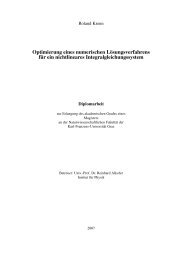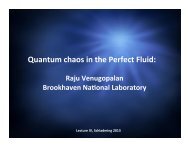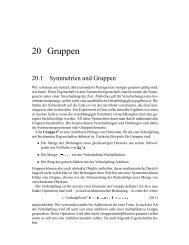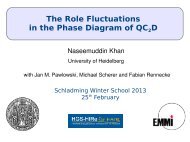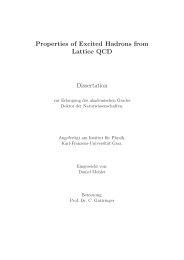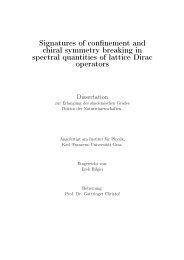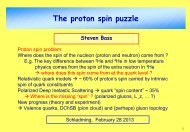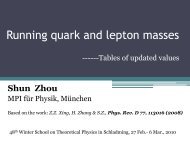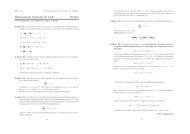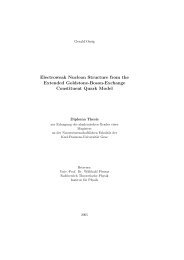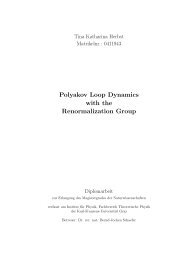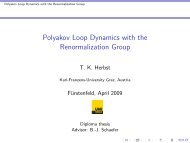The QCD Quark Propagator in Coulomb Gauge and - Institut für Physik
The QCD Quark Propagator in Coulomb Gauge and - Institut für Physik
The QCD Quark Propagator in Coulomb Gauge and - Institut für Physik
Create successful ePaper yourself
Turn your PDF publications into a flip-book with our unique Google optimized e-Paper software.
86 6.5. Nucleon electromagnetic form factors: results<br />
2<br />
1.5<br />
/ G M<br />
p<br />
µ p<br />
G E<br />
p<br />
1<br />
0.5<br />
0<br />
-0.5<br />
SLAC<br />
JLab 1<br />
JLab 2<br />
0 2 4 6 8 10<br />
Q 2 [GeV 2 ]<br />
Figure 6.6: <strong>The</strong> same as figure 6.5 for set B only, cf. [H + 05]: the calculation is exp<strong>and</strong>ed to<br />
higher momenta.<br />
consistent with<br />
√<br />
Q<br />
2 F 2(Q 2 )<br />
F 1 (Q 2 ) ≈ constant, 2 Q2 (GeV 2 ) 6 , (6.99)<br />
as are the polarisation transfer data (however, a calculation for set B <strong>and</strong> higher momenta<br />
<strong>in</strong>dicates that this relations fails for Q 2 6GeV 2 , cf. figure 6.8) . Such behaviour has<br />
been argued to <strong>in</strong>dicate the presence of substantial orbital angular momentum <strong>in</strong> the<br />
proton [MF02, RJ04]. Orbital angular momentum is not a Po<strong>in</strong>caré <strong>in</strong>variant. However,<br />
if absent <strong>in</strong> a particular frame, it will almost <strong>in</strong>evitably appear <strong>in</strong> another frame related<br />
via a Po<strong>in</strong>caré transformation. Nonzero quark orbital angular momentum is the necessary<br />
outcome of a Po<strong>in</strong>caré covariant description. This is why the covariant Faddeev amplitude<br />
describ<strong>in</strong>g a nucleon is a matrix-valued function with a rich structure that, <strong>in</strong> the nucleons’<br />
rest frame, corresponds to a relativistic wave function with s-wave, p-wave <strong>and</strong> even d-wave<br />
components [Oet00]. <strong>The</strong> result <strong>in</strong> figure6.7 is not significantly <strong>in</strong>fluenced by details of<br />
the diquarks’ electromagnetic properties. Instead, the behaviour is primarily governed by<br />
correlations expressed <strong>in</strong> the proton’s Faddeev amplitude <strong>and</strong>, <strong>in</strong> particular, by the amount<br />
of <strong>in</strong>tr<strong>in</strong>sic quark orbital angular momentum [BKR03]. This phenomenon is analogous to<br />
that observed <strong>in</strong> connection with the pion’s electromagnetic form factor. In that <strong>in</strong>stance<br />
axial-vector components of the pion’s Bethe-Salpeter amplitude are responsible for the<br />
large Q 2 behaviour of the form factor: they alone ensure Q 2 F π (Q 2 ) ≈ constant for truly



